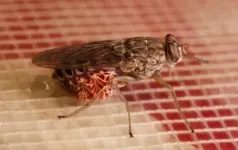(Press-News.org) Heart disease is a killer threat for southern sea otters feasting on domoic acid in their food web, according to a study led by the University of California, Davis.
The study, published in the journal Harmful Algae, examined the relationship between long-term exposure to domoic acid and fatal heart disease in southern sea otters, a threatened marine mammal.
"Sea otters are an amazing indicator of what's happening in the coastal environment, not just to other marine animals, but to us, too, especially on the issue of domoic acid," said Christine K. Johnson, director of the EpiCenter for Disease Dynamics in the One Health Institute at the UC Davis School of Veterinary Medicine and senior author of the study.
IN HOT WATER
Domoic acid is a neurotoxin that accumulates in the food web, contaminating crabs and clams -- common prey for sea otters. It is produced by harmful algal blooms, which typically occur when water is unusually warm. For example, a massive warm water "blob" in 2015 created a widespread toxic bloom along the West Coast, causing domoic acid levels to spike and forcing the closure of that season's Dungeness crab fishery.
Climate change projections indicate that toxic blooms and domoic acid exposure will continue to rise. The world's ocean temperatures in 2020 were the third highest on record, and all five of the oceans' hottest years on record occurred in the past five years.
OVER-EXPOSED OTTERS
To identify the ecological drivers of heart disease, the scientists combined several domoic acid datasets with detailed life history data from 186 free-ranging southern sea otters in California from 2001 to 2017. Of those animals, necropsy reports show that heart disease was a cause of death for 34 of the 48 otters that died during that time.
The scientists found that domoic acid exposure increased a sea otter's risk of dying with heart disease 1.7-fold. The risk is up to 2.5 times greater for otters consuming a high proportion of crab and clam, which accumulate domoic acid in their tissues, helping it persist in the food web.
The study was also the first to demonstrate a disturbing and unexpected trend: Domoic acid exposure is especially detrimental for prime-age adult sea otters, whose survival is vital for population growth.
"That's worrisome for the long-term population recovery of southern sea otters, which are a threatened species," said lead author Megan Moriarty, a wildlife veterinarian who conducted this research for her Ph.D. in epidemiology at UC Davis. "This study emphasizes that domoic acid is a threat that isn't going away. It's a food web toxin and is pretty pervasive."
Infection with Toxoplasma gondii, a parasite associated with wild and feral cat feces on land that makes its way to the ocean, also increased the risk of fatal heart disease 2.4-fold.
Co-author Melissa Miller, a veterinarian and pathologist with the California Department of Fish and Wildlife and a UC Davis One Health Institute affiliate, recently led a separate study analyzing the causes of death of sea otters.
"Improving our understanding of the effects of domoic acid on the health and population recovery of southern sea otters is extremely important" said Miller of the domoic acid study. "Given their unique biology and specialized diet, sea otters are extremely vulnerable to toxic algal blooms, which are likely to worsen with climate change. So the results of this work have far-reaching implications."
INFORMATION:
Additional co-authors for this study include M. Tim Tinker of U.S. Geological Survey and UC Santa Cruz; Joseph Tomoleoni of USGS; Michelle Staedler and Jessica Fujii of Monterey Bay Aquarium; Francesca Batac and Erin Dodd of California Department of Fish and Wildlife; Raphael Kudela of UC Santa Cruz; and Vanessa Zubkousky-White of California Department of Public Health.
The study was funded by the Morris Animal Foundation and National Science Foundation.
To enter the world of the fantastically small, the main currency is either a ray of light or electrons.
Strong beams, which yield clearer images, are damaging to specimens. On the other hand, weak beams can give noisy, low-resolution images.
In a new study published in END ...
MAPUTO, Mozambique (January 26, 2021) - A team of marine scientists led by the Wildlife Conservation Society (WCS) has confirmed that southern Africa's most threatened endemic shark - the Critically Endangered shorttail nurse shark (Pseudoginglymostoma brevicaudatum) - has been found to occur in Mozambique; a finding that represents a range extension of more than 2,000 kilometers (1,242 miles).
Publishing their findings in the journal Marine Biodiversity, the team said that the discovery was based on several records of the shark including underwater video surveys collected in 2019, recent photos of shore-based sport anglers' catches, and the identification of a specimen collected in 1967.
The ...
A hormone commonly associated with sleep-wake regulation has been found to reduce cysts in fruit flies, according to Concordia researchers. It's a finding that may affect the way we treat some kidney diseases and reduce the need for kidney transplants.
In a new paper published in the journal END ...
STUDY PROFILES IMMUNE CELLS FIGHTING COVID-19, MAY HELP GUIDE NEXT-GEN VACCINE DEVELOPMENT
Media Contact: Michael E. Newman, mnewma25@jhmi.edu
Even as the first vaccines for SARS-CoV-2, the virus that causes COVID-19, are being distributed, scientists and clinicians around the world have remained steadfast in their efforts to better understand how the human immune system responds to the virus and protects people against it. Now, a research team -- led by Johns Hopkins Medicine and in collaboration with ImmunoScape, a U.S.-Singapore biotechnology company -- has published one of the most comprehensive characterizations to date of a critical contributor to that protection: ...
Biologists often study animal sociality by collecting observations about several types of behavioral interactions. These interactions can be things like severe fights, minor fights, cooperative food sharing, or grooming each other.
But to analyze animal behavior, researchers need to make decisions about how to categorize these interactions and how to code these behaviors during data collection. Turns out, this question can be complicated.
Researchers at the University of Cincinnati dug into this tricky question while studying monk parakeets. In new research, published in the journal Current Zoology, the team asked: How do you properly categorize two seemingly similar behaviors? The study was led by UC ...
University of Alberta researchers have taken another step forward in developing an artificial intelligence tool to predict schizophrenia by analyzing brain scans.
In recently published research, the tool was used to analyze functional magnetic resonance images of 57 healthy first-degree relatives (siblings or children) of schizophrenia patients. It accurately identified the 14 individuals who scored highest on a self-reported schizotypal personality trait scale.
Schizophrenia, which affects 300,000 Canadians, can cause delusions, hallucinations, disorganized ...
SAN ANTONIO and BOSTON - Study findings released Tuesday in the Journal of the American Medical Association (JAMA) hold both good news and bad news about transient ischemic attacks (TIAs), which are harbingers of subsequent strokes.
Sudha Seshadri, MD, professor of neurology at The University of Texas Health Science Center at San Antonio and director of the university's Glenn Biggs Institute for Alzheimer's and Neurodegenerative Diseases, is senior author of the study and senior investigator of the Framingham Heart Study, from which the findings are derived. She said the extensive follow-up of Framingham participants over more than six decades enabled the study to present a more-complete picture of the risk of stroke to patients after a TIA.
The study points to the need for ...
COLUMBUS, Ohio - Research led by The Ohio State University Wexner Medical Center and College of Medicine identified a new compound that might serve as a basis for developing a new class of drugs for diabetes.
Study findings are published online in the journal Nature Chemical Biology.
The adenosine monophosphate-activated protein kinase (Ampk) is a crucial enzyme involved in sensing the body's energy stores in cells. Impaired energy metabolism is seen in obesity, which is a risk factor for diabetes. Some medications used to treat diabetes, such as metformin, work by increasing the activity of Ampk.
"In ...
African trypanosomiasis (also known as sleeping sickness) is a disease transmitted by tsetse flies and is fatal to humans and other animals; however, there is currently no vaccine, this disease is mainly controlled by reducing insect populations and patient treatment. A study published in the open access journal PLOS Biology by Alvaro Acosta-Serrano at Liverpool School of Tropical Medicine and an international team of researchers suggests that the approved drug nitisinone could be repurposed to kill tsetse flies without harming important pollinator insects.
Currently, the most effective method of controlling the transmission of African trypanosomiasis is by employing insecticide-based vector control campaigns (traps, targets, ...
The COHERENT particle physics experiment at the Department of Energy's Oak Ridge National Laboratory has firmly established the existence of a new kind of neutrino interaction. Because neutrinos are electrically neutral and interact only weakly with matter, the quest to observe this interaction drove advances in detector technology and has added new information to theories aiming to explain mysteries of the cosmos.
"The neutrino is thought to be at the heart of many open questions about the nature of the universe," said Indiana University physics professor Rex Tayloe. He led the installation, operation and data analysis of a cryogenic liquid argon ...






